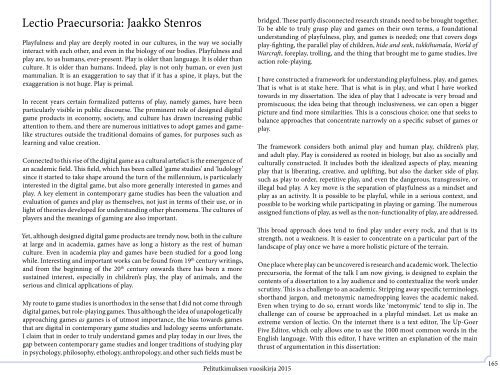ptvk2015
ptvk2015
ptvk2015
You also want an ePaper? Increase the reach of your titles
YUMPU automatically turns print PDFs into web optimized ePapers that Google loves.
Lectio Praecursoria: Jaakko Stenros<br />
Playfulness and play are deeply rooted in our cultures, in the way we socially<br />
interact with each other, and even in the biology of our bodies. Playfulness and<br />
play are, to us humans, ever-present. Play is older than language. It is older than<br />
culture. It is older than humans. Indeed, play is not only human, or even just<br />
mammalian. It is an exaggeration to say that if it has a spine, it plays, but the<br />
exaggeration is not huge. Play is primal.<br />
In recent years certain formalized patterns of play, namely games, have been<br />
particularly visible in public discourse. The prominent role of designed digital<br />
game products in economy, society, and culture has drawn increasing public<br />
attention to them, and there are numerous initiatives to adopt games and gamelike<br />
structures outside the traditional domains of games, for purposes such as<br />
learning and value creation.<br />
Connected to this rise of the digital game as a cultural artefact is the emergence of<br />
an academic field. This field, which has been called ‘game studies’ and ‘ludology’<br />
since it started to take shape around the turn of the millennium, is particularly<br />
interested in the digital game, but also more generally interested in games and<br />
play. A key element in contemporary game studies has been the valuation and<br />
evaluation of games and play as themselves, not just in terms of their use, or in<br />
light of theories developed for understanding other phenomena. The cultures of<br />
players and the meanings of gaming are also important.<br />
Yet, although designed digital game products are trendy now, both in the culture<br />
at large and in academia, games have as long a history as the rest of human<br />
culture. Even in academia play and games have been studied for a good long<br />
while. Interesting and important works can be found from 19 th century writings,<br />
and from the beginning of the 20 th century onwards there has been a more<br />
sustained interest, especially in children’s play, the play of animals, and the<br />
serious and clinical applications of play.<br />
My route to game studies is unorthodox in the sense that I did not come through<br />
digital games, but role-playing games. Thus although the idea of unapologetically<br />
approaching games as games is of utmost importance, the bias towards games<br />
that are digital in contemporary game studies and ludology seems unfortunate.<br />
I claim that in order to truly understand games and play today in our lives, the<br />
gap between contemporary game studies and longer traditions of studying play<br />
in psychology, philosophy, ethology, anthropology, and other such fields must be<br />
Pelitutkimuksen vuosikirja 2015<br />
bridged. These partly disconnected research strands need to be brought together.<br />
To be able to truly grasp play and games on their own terms, a foundational<br />
understanding of playfulness, play, and games is needed; one that covers dogs<br />
play-fighting, the parallel play of children, hide and seek, tukkihumala, World of<br />
Warcraft, foreplay, trolling, and the thing that brought me to game studies, live<br />
action role-playing.<br />
I have constructed a framework for understanding playfulness, play, and games.<br />
That is what is at stake here. That is what is in play, and what I have worked<br />
towards in my dissertation. The idea of play that I advocate is very broad and<br />
promiscuous; the idea being that through inclusiveness, we can open a bigger<br />
picture and find more similarities. This is a conscious choice; one that seeks to<br />
balance approaches that concentrate narrowly on a specific subset of games or<br />
play.<br />
The framework considers both animal play and human play, children’s play,<br />
and adult play. Play is considered as rooted in biology, but also as socially and<br />
culturally constructed. It includes both the idealized aspects of play, meaning<br />
play that is liberating, creative, and uplifting, but also the darker side of play,<br />
such as play to order, repetitive play, and even the dangerous, transgressive, or<br />
illegal bad play. A key move is the separation of playfulness as a mindset and<br />
play as an activity. It is possible to be playful, while in a serious context, and<br />
possible to be working while participating in playing or gaming. The numerous<br />
assigned functions of play, as well as the non-functionality of play, are addressed.<br />
This broad approach does tend to find play under every rock, and that is its<br />
strength, not a weakness. It is easier to concentrate on a particular part of the<br />
landscape of play once we have a more holistic picture of the terrain.<br />
One place where play can be uncovered is research and academic work. The lectio<br />
precursoria, the format of the talk I am now giving, is designed to explain the<br />
contents of a dissertation to a lay audience and to contextualize the work under<br />
scrutiny. This is a challenge to an academic. Stripping away specific terminology,<br />
shorthand jargon, and metonymic namedropping leaves the academic naked.<br />
Even when trying to do so, errant words like ‘metonymic’ tend to slip in. The<br />
challenge can of course be approached in a playful mindset. Let us make an<br />
extreme version of lectio. On the internet there is a text editor, The Up-Goer<br />
Five Editor, which only allows one to use the 1000 most common words in the<br />
English language. With this editor, I have written an explanation of the main<br />
thrust of argumentation in this dissertation:<br />
165


